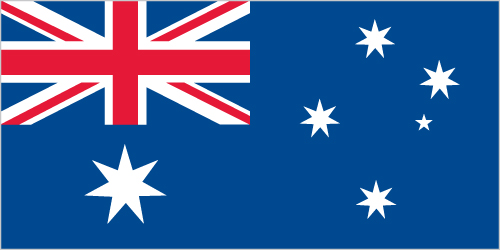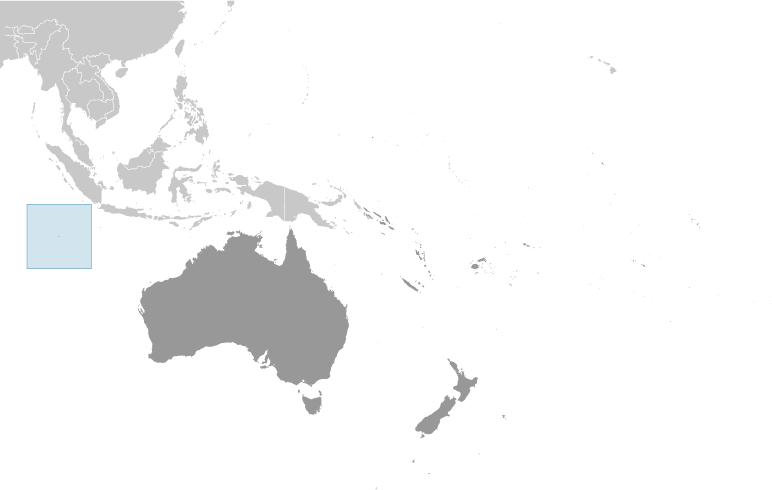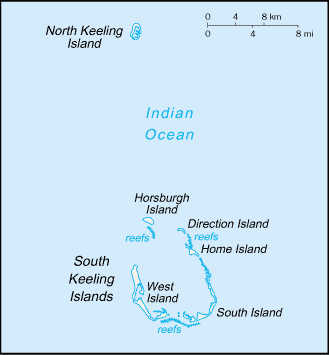


Australia - Oceania ::
Cocos (Keeling) Islands
-
Introduction :: Cocos (Keeling) Islands
-
Background:There are 27 coral islands in the group. Captain William KEELING discovered the islands in 1609, but they remained uninhabited until the 19th century. From the 1820s to 1978, members of the CLUNIES-ROSS family controlled the islands and the copra produced from local coconuts. Annexed by the UK in 1857, the Cocos Islands were transferred to the Australian Government in 1955. Apart from North Keeling Island, which lies 30 kilometers north of the main group, the islands form a horseshoe-shaped atoll surrounding a lagoon. North Keeling Island was declared a national park in 1995 and is administered by Parks Australia. The population on the two inhabited islands generally is split between the ethnic Europeans on West Island and the ethnic Malays on Home Island.
-
Geography :: Cocos (Keeling) Islands
-
Location:Southeastern Asia, group of islands in the Indian Ocean, southwest of Indonesia, about halfway between Australia and Sri LankaGeographic coordinates:12 30 S, 96 50 EMap references:Southeast AsiaArea:total: 14 sq kmland: 14 sq kmwater: 0 sq km
note: includes the two main islands of West Island and Home Island
country comparison to the world: 241Area - comparative:about 24 times the size of The Mall in Washington, DCLand boundaries:0 kmCoastline:26 kmMaritime claims:territorial sea: 12 nmexclusive fishing zone: 200 nmClimate:tropical with high humidity, moderated by the southeast trade winds for about nine months of the yearTerrain:flat, low-lying coral atollsElevation:lowest point: Indian Ocean 0 mhighest point: South Point on South Island 9 mNatural resources:fishLand use:agricultural land: 0% (2011 est.)arable land: 0% (2011 est.) / permanent crops: 0% (2011 est.) / permanent pasture: 0% (2011 est.)forest: 0% (2011 est.)other: 100% (2011 est.)Irrigated land:NAPopulation distribution:only Home Island and West Island are populatedNatural hazards:cyclone season is October to AprilEnvironment - current issues:freshwater resources are limited to rainwater accumulations in natural underground reservoirs; illegal fishing a concernGeography - note:islands are thickly covered with coconut palms and other vegetation; site of a World War I naval battle in November 1914 between the Australian light cruiser HMAS Sydney and the German raider SMS Emden; after being heavily damaged in the engagement, the Emden was beached by her captain on North Keeling Island -
People and Society :: Cocos (Keeling) Islands
-
Population:596 (July 2014 est.)country comparison to the world: 237Nationality:noun: Cocos Islander(s)adjective: Cocos IslanderEthnic groups:Europeans, Cocos MalaysLanguages:English 22.3%, Malay (Cocos dialect) 68.8%, unspecified 8.9% (2016 est.)
note: data represent language spoken at home
Religions:Muslim (predominantly Sunni) 75%, Anglican 3.5%, Roman Catholic 2.2%, none 12.9%, unspecified 6.3% (2016 est.)Population growth rate:0% (2014 est.)country comparison to the world: 193Population distribution:only Home Island and West Island are populatedInfant mortality rate:total: NA (2018)male: NAfemale: NALife expectancy at birth:total population: NA (2017 est.)male: NAfemale: NATotal fertility rate:NAHIV/AIDS - adult prevalence rate:NAHIV/AIDS - people living with HIV/AIDS:NAHIV/AIDS - deaths:NA -
Government :: Cocos (Keeling) Islands
-
Country name:conventional long form: Territory of Cocos (Keeling) Islandsconventional short form: Cocos (Keeling) Islandsetymology: the name refers to the abundant coconut trees on the islands and to English Captain William KEELING, the first European to sight the islands in 1609Dependency status:non-self governing territory of Australia; administered from Canberra by the Department of Regional Australia, Local Government, Arts and SportGovernment type:non-self-governing overseas territory of AustraliaCapital:name: West Islandgeographic coordinates: 12 10 S, 96 50 Etime difference: UTC+6.5 (11.5 hours ahead of Washington, DC, during Standard Time)Administrative divisions:none (territory of Australia)Independence:none (territory of Australia)National holiday:Australia Day (commemorates the arrival of the First Fleet of Australian settlers), 26 January (1788)Constitution:history: 23 November 1955 (Cocos (Keeling) Islands Act 1955)amendments: amended many times, last in 2016 (2017)Legal system:common law based on the Australian modelCitizenship:see AustraliaSuffrage:18 years of ageExecutive branch:chief of state: Queen ELIZABETH II (since 6 February 1952); represented by Governor General of the Commonwealth of Australia General Sir Peter COSGROVE (since 28 March 2014)head of government: Administrator Natasha GRIGGS (since 5 October 2018)cabinet: NAelections/appointments: the monarchy is hereditary; governor general appointed by the monarch on the recommendation of the Australian prime minister; administrator appointed by the governor general for a 2-year term and represents the monarch and AustraliaLegislative branch:description: unicameral Cocos (Keeling) Islands Shire Council (7 seats; members directly elected by simple majority vote to serve 4-year terms with half the membership renewed every 2 years)elections: last held in October 2017 (next to be held on 31 October 2019)election results: percent of vote by party - NA; seats by party - NA; composition - men 5, women 2, percent of women 28.6%Judicial branch:under the terms of the Territorial Law Reform Act 1992, Western Australia provides court services as needed for the island including the Supreme Court and subordinate courts (District Court, Magistrate Court, Family Court, Children's Court, and Coroners' Court)Political parties and leaders:noneInternational organization participation:noneDiplomatic representation in the US:none (territory of Australia)Diplomatic representation from the US:none (territory of Australia)Flag description:the flag of Australia is usedNational anthem:
note: as a territory of Australia, "Advance Australia Fair" remains official as the national anthem, while "God Save the Queen" serves as the royal anthem (see Australia)
-
Economy :: Cocos (Keeling) Islands
-
Economy - overview:Coconuts, grown throughout the islands, are the sole cash crop. Small local gardens and fishing contribute to the food supply, but additional food and most other necessities must be imported from Australia. There is a small tourist industry.GDP (purchasing power parity):
NA
GDP - real growth rate:1% (2003)country comparison to the world: 183Agriculture - products:vegetables, bananas, pawpaws, coconutsIndustries:copra products, tourismLabor force:NALabor force - by occupation:note: the Cocos Islands Cooperative Society Ltd. employs construction workers, stevedores, and lighterage workers; tourism is the other main source of employment
Unemployment rate:0.1% (2011)60% (2000 est.)country comparison to the world: 1Budget:revenues: NAexpenditures: NAFiscal year:1 July - 30 JuneExports:NA
Exports - commodities:copraImports:NA
Imports - commodities:foodstuffsExchange rates:Australian dollars (AUD) per US dollar -1.311 (2017 est.)1.3442 (2016 est.)1.3442 (2015)1.3291 (2014)1.1094 (2013) -
Communications :: Cocos (Keeling) Islands
-
Telephone system:general assessment: telephone service is part of the Australian network; an operational local mobile-cellular network available; wireless Internet connectivity availabledomestic: local area code - 08international: international code - 61 8; telephone, telex, and facsimile communications with Australia and elsewhere via satellite; satellite earth station - 1 (Intelsat)Broadcast media:1 local radio station staffed by community volunteers; satellite broadcasts of several Australian radio and TV stations available (2017)Internet country code:.cc
-
Military and Security :: Cocos (Keeling) Islands
-
Military - note:defense is the responsibility of Australia; the territory has a five-person police force
-
Transportation :: Cocos (Keeling) Islands
-
Airports:1 (2013)country comparison to the world: 218Airports - with paved runways:total: 1 (2019)2,438 to 3,047 m: 1Roadways:total: 22 km (2007)paved: 10 km (2007)unpaved: 12 km (2007)country comparison to the world: 213Ports and terminals:major seaport(s): Port Refuge
-
Transnational Issues :: Cocos (Keeling) Islands
-
Disputes - international:
none